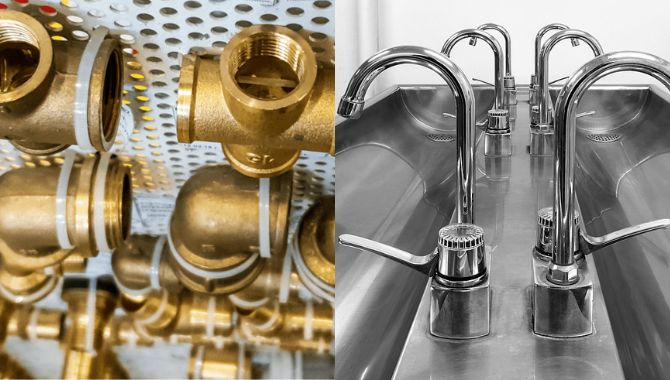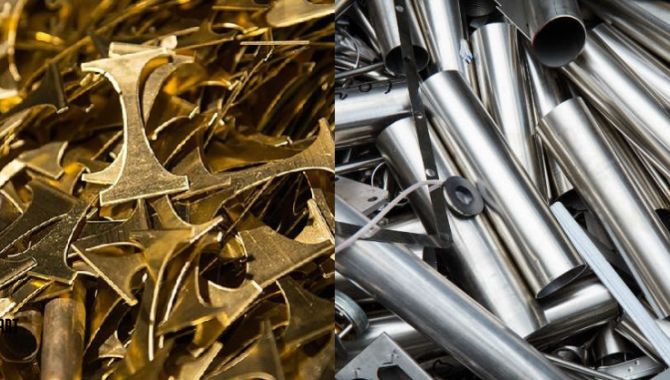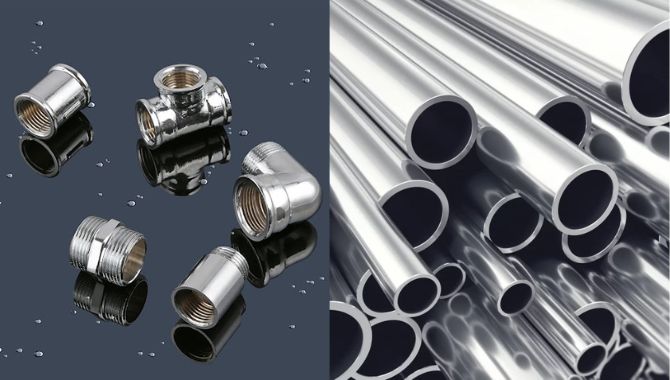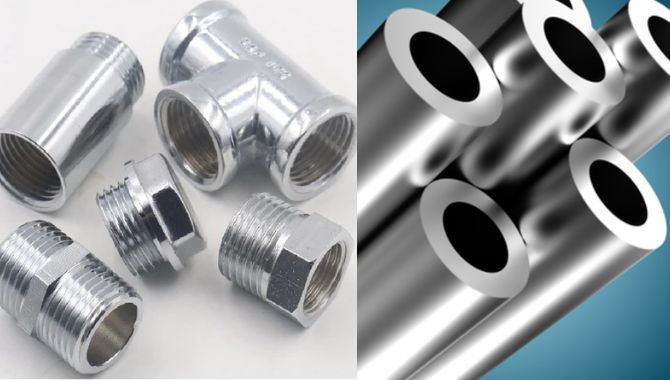Durability is an important factor when choosing materials for difficult operations. Brass with chrome finish and stainless steel are the best options and they mostly compete. To see which one is more powerful, let’s examine the important factors that decide durability and see how chrome plated brass vs. stainless steel measures up.
Materials Overview

Chromium-plated brass unites the protective chromium layer and the strength of brass. This mixed material gives average aesthetic appeal and corrosion protection.
Stainless steel as an iron-based alloy with at least 10.5% chromium and has built-in corrosion resistance from its self-healing chromium oxide film. Its composition gives superior strength and durability which makes it perfect for challenging situations across industries.
Chemical Composition Comparison:
| Element | Chromium Plated Brass (%) | Stainless Steel (%) |
| Copper | 57-61 | – |
| Zinc | 35-39 | – |
| Lead | 2-3 | – |
| Chromium | 0.2-0.3 (plating) | 10.5-30 |
| Iron | – | 50-74 |
| Carbon | – | 0.03-1.2 |
| Nickel | – | 0-22 |
| Molybdenum | – | 0-3 |
Properties Comparison
| Property | Chromium Plated Brass | Stainless Steel |
| Density (g/cm³) | 8.4-8.7 | 7.5-8.0 |
| Melting Point (°C) | 900-940 | 1400-1530 |
| Electrical Conductivity (% IACS) | 28 | 2.5 |
| Thermal Conductivity (W/m·K) | 109-121 | 16-24 |
| Yield Strength (MPa) | 170-310 | 205-515 |
| Tensile Strength (MPa) | 340-510 | 515-827 |
| Hardness (Brinell) | 110-150 | 160-190 |
| Corrosion Resistance | Moderate | Excellent |
Chromium Plated Brass vs. Stainless Steel: Comparing Top 5 Durability Factors
Factor 1: Corrosion Resistance

Corrosion resistance has a huge role in material life span especially in corrosive settings. Let’s see how our contenders perform:
Chromium Coated Brass
A thin chromium layer (0.3-0.5 microns) shields plated brass from corrosion. Even though this barrier protects against oxidation and chemical attack it is not indestructible. This protective coating can wear away over time, particularly in harsh conditions like coastal or heavy chemical industrial areas.
Impacts, scratches or general wear can damage the chrome layer which leaves the basic brass open to corrosion. For example, in marine uses saltwater quickly degrades exposed brass that needs frequent replacement or maintenance.
Stainless Steel
Stainless steel’s corrosion resistance comes from within. Its chromium content forms a passive oxide layer on the surface that continuously regenerates when damaged. This self-healing property gives stainless steel a great edge in corrosive environments.
You’ll find stainless steel maintaining its integrity far longer than chrome brass in highly acidic or chloride-rich settings such as offshore oil rigs or chemical processing plants. Its resistance to pitting and crevice corrosion makes it best for situations where long-term reliability is needed.
In the corrosion resistance arena, stainless steel outperforms chromium-plated brass, particularly in harsh environments and over extended periods.
Factor 2: Wear and Abrasion Resistance

The ability to withstand mechanical wear, impact and scratching is important in situations where surfaces face abrasive forces or constant friction.
Chromium Plated Brass
Chrome plating provides moderate abrasion resistance to brass usually with a hardness of 850-1000 HV. However, this thin layer (usually 0.3-0.5 microns) is liable to denting and scratching. In high-traffic areas like faucets or door handles, the chrome layer can wear away and expose the softer brass underneath (Vickers hardness of 100-200 HV).
You’ll usually need potential re-plating and frequent maintenance to maintain protection. In industrial settings with abrasive particles such as mining equipment, chromium-plated brass components may require more frequent replacement.
Stainless Steel
The durability of stainless steel comes from its alloy makeup which permits superior wear resistance. With a hardness ranging from 150-200 HV for austenitic types to over 500 HV for martensitic types, it keeps its strength over time.
In high-wear uses like food processing machinery or conveyor systems, stainless steel greatly outperforms chromium plated brass. Its work-hardening properties further increase surface hardness under stress which makes it perfect for places with constant impact or abrasion.
When it comes to wear and abrasion resistance, stainless steel beats chrome brass particularly in demanding industrial uses.
Factor 3: Impact Resistance

When selecting materials for pipe fittings, impact resistance has an important role. This property shows how well a material can take sudden forces without bending or breaking. Let’s compare stainless steel and chrome-coated brass for impact resistance.
Chromium-Plated brass
Chrome brass has moderate impact resistance because of its brass core. It can handle some sudden forces with an impact strength of 20-30 J/cm2. However, the thin chrome layer (0.3-0.5 microns) is at risk of chipping or cracking on impact. This damage can reduce protection and allow corrosion.
You’ll need to be careful when using brass with chrome finish in a corrosive environment. Industrial valves and car parts made from this material may need frequent replacements or inspections. Chromium-plated brass can wear out quickly in harsh places like factories with heavy machinery or construction sites.
Stainless Steel
Stainless steel stands out with its superior impact resistance. It has impact strengths ranging from 40-350 J/cm2 depending on the grade. This impressive performance comes from its alloying elements and crystal structure. Austenitic stainless steels excel in low-temperature toughness which makes them perfect for cryogenic uses.
You can depend on stainless steel parts to go through with heavy impacts and use without compromising their protective qualities. For example, in demanding situations like food processing plants or offshore platforms, stainless steel preserves its integrity much longer than chrome-coated brass.
Factor 4: Maintenance Requirements

The maintenance requirements of materials greatly affect their overall performance and long-term durability. Now we will compare stainless steel and chromium-plated brass in this aspect.
Chromium-Pated Brass
Chrome brass needs regular care because it is vulnerable to wear and corrosion. The thin chrome layer (0.3-0.5 microns) can degrade over time particularly in harsh conditions. While using this material in industrial or coastal settings with high chemical exposure maintenance may be needed every 6 to 12 months.
When large wear or damage happens, re-plating becomes necessary. This process can be time-consuming and costly. For example, in marine uses, saltwater speeds up corrosion and requires more frequent inspections and potential replacement or re-plating of parts.
Stainless Steel
In contrast, stainless steel needs little maintenance because of its self-healing chromium oxide layer. This thin passive film which measures 1 to 3 nanometers thick, continuously re-forms when damaged. So it gives constant protection against wear and corrosion.
Even in tough settings like food production facilities or chemical processing plants, stainless steel parts mostly need routine cleaning to keep their integrity. The material’s built-in wear and corrosion resistance means less frequent maintenance and lower long-term costs.
So in comparison with plated brass, stainless steel requires less maintenance. This advantage brings reduced operating costs and better long-term reliability for pipe fitting uses.
Factor 5: Long-Term Cost Effectiveness

Cost-effectiveness considers how durable materials impact total project costs which include both upfront investment and long-term expenses. This factor is very important in budget planning and lifecycle cost analysis.
Chromium Plated Brass
Chrome-coated brass has lower initial costs usually 20 to 30% less than stainless steel. This makes it attractive for short-term projects or lower durability needs. However, the possible re-plating, ongoing maintenance and shorter lifespan can mean higher overall costs long term.
In harsh environments like marine uses or chemical plants, chrome brass parts may need replacement every 2 to 5 years. The cumulative cost of maintenance and replacements can exceed the initial savings within a decade.
Stainless Steel
Despite the higher initial investment, durability of stainless steel, low maintenance needs and long lifespan mean lower total ownership costs. In corrosive environments like food processing plants or offshore oil rigs, stainless parts can last 15 to 20 years or more with minimal upkeep.
The investment in stainless pays off over time especially where wear resistance and durability are sensitive. For example, in industrial piping systems, the lifecycle cost of stainless steel can be up to 33% lower than chromium-plated brass over 20 years.
In summary, stainless proves more cost-effective in the long term, particularly in demanding situations because of its lower maintenance needs and superior durability.
Comparison table:
| Factor | Chromium Plated Brass | Stainless Steel |
| Corrosion Resistance | Moderate • Chrome layer can wear away over time • Relies on a thin chrome layer (0.3-0.5 microns) • Vulnerable in harsh environments (e.g., coastal areas, industrial settings) | High • Forms a self-healing passive oxide layer • Inherently resistant due to chromium content • Excellent performance in corrosive environments |
| Wear Resistance | Moderate • Hardness: 850-1000 HV (chrome layer) • Requires frequent maintenance in high-traffic areas • Prone to scratches and denting • Underlying brass: 100-200 HV | High • Hardness: 150-200 HV (austenitic), >500 HV (martensitic) • Work-hardening properties improve surface hardness under stress • Excellent durability and hardness |
| Impact Resistance | Moderate • Impact strength: 20-30 J/cm² • Performance degrades in harsh environments • Chrome layer can crack or chip under impact | High • Impact strength: 40-350 J/cm² (grade-dependent) • Excellent toughness, even at low temperatures • Maintains integrity under heavy impacts |
| Maintenance Requirements | High • Requires regular maintenance • Maintenance frequency: every 6-12 months in harsh environments • Needs re-plating in cases of significant wear | Low • Minimal maintenance due to self-healing properties • Longer intervals between maintenance cycles • Only routine cleaning is required in most cases |
| Cost Effectiveness | • Lower initial cost (20-30% less than stainless steel) • Higher long-term maintenance costs • Cumulative costs exceed initial savings within a decade • Replacement is needed every 2-5 years in harsh environments | • Higher initial cost • Lower total ownership costs over time • Up to 33% lower lifecycle cost over 20 years in industrial applications • Can last 15-20 years or more with minimal maintenance |
Conclusion
For durability, stainless steel is the clear winner. Its superior wear resistance, corrosion resistance and impact strength make it the best choice for tough situations. While chrome coated brass may have short-term cost savings, lower maintenance and long-term durability of stainless steel give better value over time.
For expert advice on chromium plated brass and stainless steel for your project, contact KDM Fabrication. Our team gives professional guidance and top-quality services to meet your particular needs and requirements.
Frequently Asked Questions:
Which Material is Suitable for Piping – Chromium Plated Brass or Stainless Steel?
The best choice between chrome coated brass and stainless steel for piping depends on the particular use. Plated brass delivers corrosion protection, lower cost and an attractive look which makes it great for decorative uses and home plumbing.
But stainless steel has superior strength, durability and corrosion resistance. So it is better for industrial uses, high-pressure systems, and extreme surroundings of temperatures or chemicals.
What are the 3 Pros and Cons of Chrome Plating and Stainless Steel?
Chrome plating has three main advantages which are outstanding scratch resistance from its hardness, high visual appeal with a mirror-like shine and easy maintenance with simple cleaning. However, it also has three notable disadvantages damage that are, it is hard to repair without replacing the whole part, it can be pricey and has possible surrounding impact from chemicals used in the plating process.
Stainless steel also has many benefits. The three big pros are high corrosion protection due to the chromium oxide layer, outstanding longevity as it doesn’t weaken over time and high durability and strength from its alloy composition. Its three main cons are prone to scratches and dents, higher cost than some other materials and difficulty in welding due to its high melting point.




